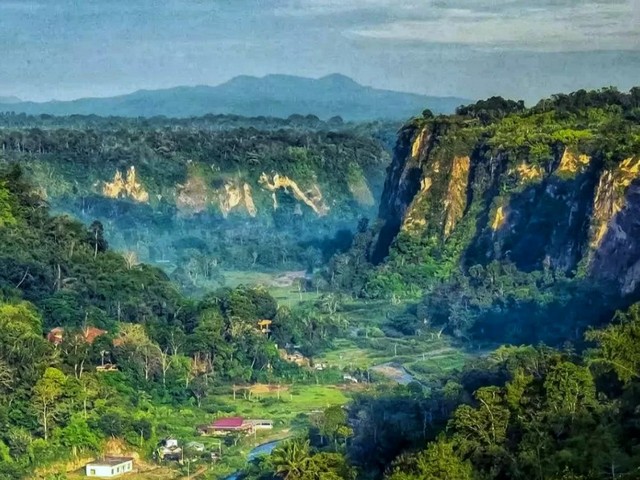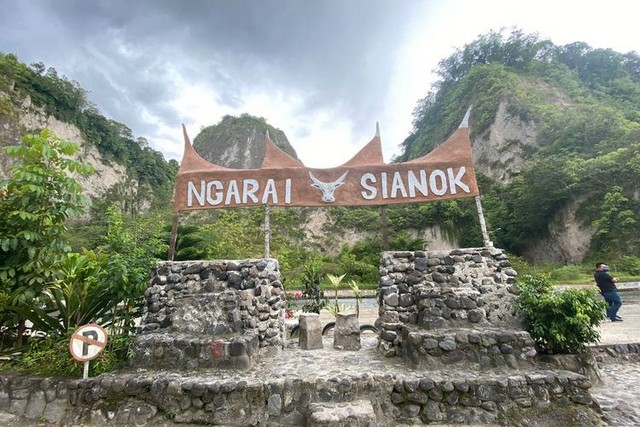Sianok Canyon, Grand Canyon of West Sumatra, Indonesia
Sianok Canyon is a natural feature of a steep valley or famous ravine, there is even an interesting name "Sianok Canyon, Grand Canyon of West Sumatra, Indonesia".
The location of Sianok Canyon is on the border of Bukittinggi City with Agam Regency, precisely in District IV Koto, West Sumatra.
 |
| (Photo: Z Creators/Rivo Wijaya) |
This canyon is unique because of its shape which extends from the south of Nagari Koto Gadang to Nagari Sianok Anam Suku.
The beauty of Sianok Canyon as a tourist destination is already well-known to foreign countries.
Sianok Canyon Shape
Sianok Canyon is a narrow valley surrounded by cliff hills decorated with a small river flow in the middle.
The cliff has a height of about 100 m, stretches for 15 km, and a width of approximately 200 m.
The contour of the Sianok Valley was formed due to the process of partial descent of the earth's plates, causing a fault in the form of a cliff.
 |
| (Photo: empimuslion.files.wordpress.com) |
Sianok Canyon is the clearest visual manifestation of the activity of the earth's plate movement (tectonics) on the island of Sumatra.
The process of forming the fault produces a fertile area with a beautiful panorama.
This area has another name, namely the Valley of Quiet, because of its calm and peaceful atmosphere. In unspoiled areas, some flora and fauna are found in this area.
The flora in the Sianok Canyon area is rafflesia flowers and medicinal plants. Meanwhile, the fauna found in this area is in the form of leopards, monkeys, gibbons, deer, wild boars, tapirs, and buffaloes.
The History of Sianok Canyon
Sianok Canyon was formed due to an ancient volcanic eruption located on Lake Maninjau, now the mountain is called Mount Tinjau.
Also, read: Mentawai, A Beauty of Indonesia from Natural Charm to the Oldest Tattoo Tradition in the World.
Through horizontal shift movements of 2 mm/day over thousands of years, a wide gap was formed.
The geological processes that occur in Sianok Canyon come from outside the earth (exogenous) and inside the earth (endorgent). The resulting landform is a valley and a vast towering cliff.
The Myth of Sianok Canyon
The myth that developed in Sianok Canyon, according to ancient people there was a man who had a large body, skin as hard as copper, and magic named Katik Muno.
He came to accompany his leader, the Sapurba. During his stay in Minangkabau, Katik Muno wanted to become a ruler. Because his will is very strong, Katik, who originally had a meek nature, became a bad and rude person. His crimes resulted in the suffering of the surrounding population.
 |
| (Photo: Z Creators/Rivo Wijaya) |
Seeing his behavior, Sang Sapurba felt very embarrassed. In order not to conflict with their superiors, Katik Muno turned into a dragon and then divided the mainland into two parts. The divided land is Sianok Canyon.
At the beginning of its formation, the canyon was fed by smoldering fire. But after the battle between Katik and Sang Sapurba which was won by his superior, Katik Muno changed the flow of fire into a stream of soothing water as an apology.
Interesting Facts about Sianok Canyon
1. The Nickname of the Quiet Valley
The origin of the name of Sianok Canyon comes from one of the Nagari that stands at the bottom of the valley.
The name 'Sianok' consists of two words namely 'Si' and 'Anok' which means the Quiet One. So do not be surprised if then the nickname Pendiam Valley is pinned to this place because the atmosphere is so calm and peaceful.
2. Results of fault activity on the island of Sumatra
Sianok Canyon is a natural feature that is influenced by fault activity in Sumatra called the Semangko Fault.
The Semangko Fault is a fault that cuts through the western side of Sumatra Island from Aceh to Lampung, which forms the Bukit Barisan Mountain range.
While in Sianok Canyon, the Semangko Fault forms a lush green valley surrounded by steep walls. While in the green part of the valley also flows by the Batang Sianok or Sianok River.
3. A very deep abyss
The morphology of Sianok Canyon as a containment has a depth of about 100 meters from the top of the cliff, to the bottom.
Semantara in the valley is quite narrow and has a width of about 200 meters. Sianok Canyon stretches and winds as a city boundary line with a length of about 15 kilometers.
4. Habitat of flora and fauna
Sianok Canyon is known as fertile land, so it is not surprising if the scenery is a stretch of green path.
This valley is also a habitat for various flora and fauna, ranging from commonly found to rare. Call it raflesia flowers, gibbons, long-tailed monkeys, deer, to tapirs live in Sianok Canyon.
5. Interesting activities for tourists
Various activities can be done by tourists while visiting Sianok Canyon. Tourists can take pictures or exercise by trekking, cycling, or just taking a light walk to relieve fatigue.
There are several tourism facilities, including rafting, kayaking, and canoeing. Around Sianok Canyon there are also popular tourist spots such as Janjang Koto Gadang, Janjang Saribu, and Janjang 40.
6. Emblazoned on banknotes
Because its charm has been famous throughout the world, it is not surprising that the beauty of Sianok Canyon is displayed on rupiah banknotes.
 |
| (Photo: Kompas.com/Faqihah Muharroroh Itsnaini) |
The picture of Sianok Canyon is on the back of the IDR 2,000 bill in 2022 which carries a typical Indonesian series. On the banknote, the natural beauty of Sianok Canyon is combined with the elegance of Jeumpa Flowers and the figure of a woman performing a plate dance.
That's a little information about the beauty of Indonesian tourism, especially "Ngarai Sianok, Grand Canyon of West Sumatra, Indonesia". Hopefully useful and a reference for those of you who want to come and enjoy the natural beauty of Indonesia.

0 Response to "Sianok Canyon, Grand Canyon of West Sumatra, Indonesia"
Post a Comment